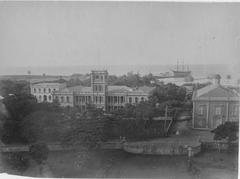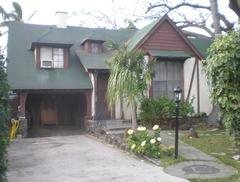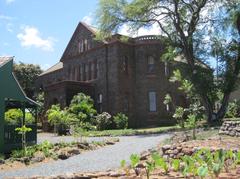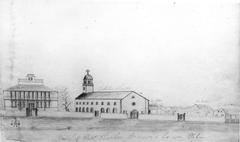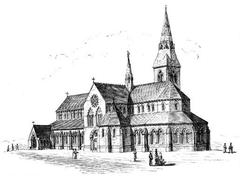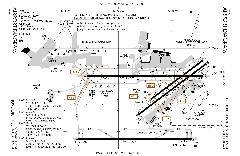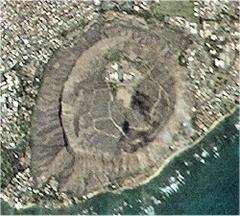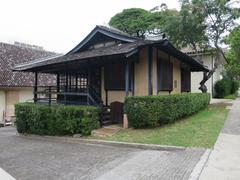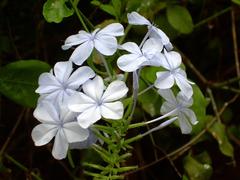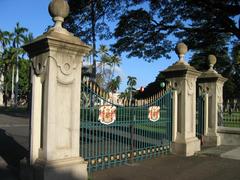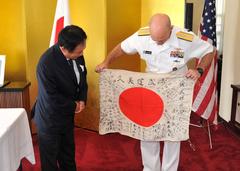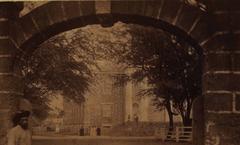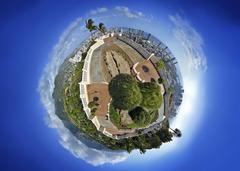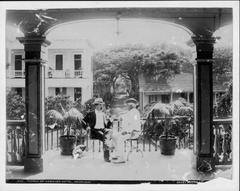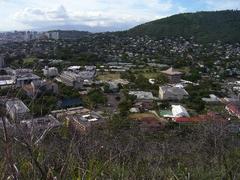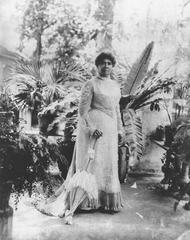
Shangri La Museum Visiting Hours, Tickets, and Honolulu Historical Sites Guide
Date: 04/07/2025
Introduction: Shangri La’s Cultural and Historical Significance
Nestled on the southeastern coast of Oʻahu, the Shangri La Museum of Islamic Art, Culture & Design is a singular institution in the United States, offering an immersive journey into the global heritage of Islamic art. Conceived by philanthropist and art collector Doris Duke in the 1930s, the estate masterfully integrates Mughal, Ottoman, Persian, Moroccan, and Spanish-Moorish influences—featuring more than 4,500 objects ranging from ceramics and textiles to architectural elements and metalwork. Beyond its role as a museum, Shangri La stands as a vibrant cultural hub, fostering intercultural dialogue, educational initiatives, and community engagement, all set within lush Mughal-inspired gardens and a dramatic oceanfront landscape (Shangri La Hawaii; Honolulu Museum of Art; Mogulesque).
This guide details everything you need to plan your visit: opening hours, ticketing, accessibility, special events, and practical tips, ensuring your encounter with this unique Honolulu historical site is enriching and memorable.
Table of Contents
- Origins and Historical Development
- Cultural Significance
- Visiting Shangri La: Hours, Tickets, and Practical Information
- Architectural and Artistic Highlights
- Contemporary Discourse and Community Engagement
- Exhibitions and Artist Residencies
- Accessibility and Visitor Services
- FAQs
- Plan Your Visit and Further Resources
Origins and Historical Development
Doris Duke’s Vision and the Birth of Shangri La
Inspired by her 1935 honeymoon through North Africa, the Middle East, and South Asia, Doris Duke commissioned a Mughal-style marble suite in India, initially intended for a Florida home. However, after falling in love with Hawaii, Duke decided to create a residence on Oʻahu to house her growing Islamic art collection. She famously stated, “The idea of building a Near Eastern house in Honolulu may seem fantastic to many… but precisely at the time I fell in love with Hawaii… a Mogul-inspired bedroom and bathroom planned for another house was being completed for me in India so there was nothing to do but have it shipped to Hawaii and build a house around it” (Mogulesque).
Construction and Architectural Evolution
Construction began in 1936 and concluded in 1938 at a cost equivalent to over $28 million today. Architect Marion Sims Wyeth collaborated with Doris Duke, local artisans, and master craftsmen from Morocco, India, Syria, and Iran to create a residence where Islamic architectural styles blend seamlessly with modernist sensibilities. The estate’s five acres feature intricately carved marble, Moroccan painted ceilings, Syrian interiors, Indian textiles, and Spanish metalwork (Shangri La Hawaii; Halekulani).
The Collection: Scope and Significance
Over six decades, Duke amassed approximately 4,500 objects, making Shangri La one of the world’s premier private collections of Islamic art. The collection includes ceramics, glass, woodwork, textiles, metalwork, and architectural fragments, with particular strengths in works from 1600–1940 CE. The estate’s charbagh gardens, modeled on Mughal precedents like Lahore’s Shalimar Gardens, further integrate art, architecture, and landscape (Mogulesque; Halekulani).
Cultural Significance
A Center for Islamic Art in the United States
Shangri La is the only standalone museum in the U.S. dedicated exclusively to Islamic art (Honolulu Museum of Art). Opened to the public in 2002, it serves as a hub for the study, preservation, and celebration of Islamic cultural heritage. The Doris Duke Foundation’s stewardship ensures ongoing research, community programming, and a commitment to representation and inclusion (Shangri La Hawaii).
Intercultural Dialogue and Community Engagement
Located in Hawaiʻi—a crossroads of Pacific cultures—Shangri La acknowledges its place on Native Hawaiian land within the ahupua‘a of Waikīkī. The museum actively partners with Native Hawaiian artists and scholars, highlighting connections between Islamic and Hawaiian traditions through exhibitions, residencies, and educational programs (Shangri La Hawaii; Halekulani).
Philanthropy and Education
The Doris Duke Foundation for Islamic Art, established in 1998, continues Duke’s legacy by supporting arts, environmental conservation, child welfare, and medical research. Shangri La’s educational initiatives include guided tours, lectures, workshops, and partnerships with the Honolulu Museum of Art, from which all tours depart (Shangri La Hawaii; Honolulu Museum of Art).
Visiting Shangri La: Hours, Tickets, and Practical Information
Visiting Hours
Shangri La is open Thursday through Saturday, with guided tours at 9:00am, 11:00am, 1:00pm, and 3:00pm. All tours begin at the Honolulu Museum of Art (Shangri La Hawaii; Oahu Activities).
Tickets and Reservations
Tickets must be reserved in advance via the Shangri La website or through the Honolulu Museum of Art. General admission is $25, with discounted rates for Hawaiʻi residents, students, military, and special $5 Kama‘āina tours on select days (Honolulu Museum of Art). Due to limited capacity, early booking is strongly advised.
Getting There
Private vehicle access to Shangri La is not permitted. Visitors park at the Honolulu Museum of Art and are transported by shuttle to the estate—a scenic 15-minute drive (InsideInside). This preserves the residential neighborhood and the site’s environment.
Architectural and Artistic Highlights
Notable Features
- Mughal Suite: White marble, jali screens, and a Taj Mahal–inspired fireplace (Mogulesque).
- Moroccan Ceilings: Gilt and painted wooden ceilings from Morocco (Halekulani).
- Syrian Interiors: Painted Ottoman-era wooden rooms.
- Indian Textiles: Colorful embroidery and fabrics.
- Spanish Metalwork: Decorative pierced metal elements.
- Gardens: Charbagh layouts, water features, and native Hawaiian plants (Mogulesque; to-hawaii.com).
Ongoing Preservation
Shangri La’s curatorial team maintains and interprets the collection to ensure respectful, relevant presentation and ongoing conservation (Shangri La Hawaii).
Contemporary Discourse and Community Engagement
Representation and Inclusion
The museum is committed to diversity, equity, and inclusion in both its programming and stewardship, supporting contemporary artists and scholars who challenge and expand understandings of Islamic art (Shangri La Hawaii).
Bridging Cultures
Programming situates Islamic art within Hawaiʻi’s multicultural context, engaging both local and global communities through exhibitions, residencies, and dialogue (Honolulu Museum of Art; Halekulani).
Exhibitions and Artist Residencies
Permanent and Temporary Exhibitions
Art is displayed in situ throughout the estate, offering an immersive experience (hulalandblog.com). Recent special exhibitions include the Ubisoft partnership exploring art in gaming (shangrilahawaii.org).
Artist Residencies
The Artist-in-Residence program brings diverse creatives to engage with the collection and community, with recent residents including Taimane, Dr. Mariam Rahmani, Chef Ahu, and Sandra Saenz (shangrilahawaii.org; stories.shangrilahawaii.org).
Accessibility and Visitor Services
- Accessibility: Wheelchair-accessible tours are available by request; contact the museum in advance (Gallery Systems PDF).
- Digital Engagement: Explore the digital eMuseum and virtual tours (Google Streetview) for remote access.
- On-site Amenities: Restrooms are available at both the Honolulu Museum of Art and Shangri La; a gift shop offers books and souvenirs. Food is not permitted during tours.
- Photography: Non-flash photography is allowed in most areas; flash and tripods are restricted.
Frequently Asked Questions (FAQs)
How do I purchase tickets?
Reserve online via the official website or Honolulu Museum of Art. All visits require advance booking.
What are the visiting hours?
Guided tours Thursday–Saturday: 9:00am, 11:00am, 1:00pm, 3:00pm.
Is the museum accessible?
Yes, with advance notice. Some historic areas have limited access.
Can I visit without a guided tour?
No; entry is by guided tour only, departing from the Honolulu Museum of Art.
Is there parking?
Yes, at the Honolulu Museum of Art.
Are virtual tours available?
Yes, through Google Streetview and digital platforms.
Plan Your Visit and Stay Connected
Book your tickets via the Shangri La website, plan ahead for accessibility needs, and explore digital resources if you cannot visit in person. For cultural enrichment, combine your visit with a tour of the Honolulu Museum of Art or nearby historical sites. Download the Audiala app for audio guides and updates, and follow Shangri La on social media to stay informed about exhibitions and events.
References and Further Reading
- Shangri La Hawaii
- Oahu Activities
- InsideInside
- To-Hawaii.com
- Honolulu Museum of Art
- Mogulesque
- Halekulani
- Shangri La News: Ubisoft Exhibition
- Doris Duke Foundation
- Shangri La Virtual Tour
- Gallery Systems PDF
- Stories: Sandra Saenz Residency
- HoMA Summer Magazine



















